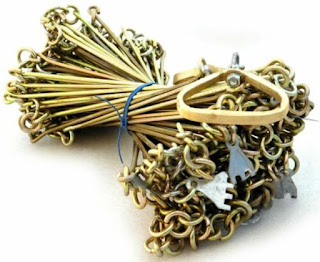Determination of the weights of people, animals or things have long been a necessity for business or pleasure and the means of determination of weight has ranged from guess work and intuition to calculation and mechanical devices.
Many years ago when the weight of things became necessary for exactness, scales were not readily available where needed and transportation to them was difficult and time consuming. For example, the weight of working oxen or beef cattle was frequently needed for selling or health, and what do you do when available hay scales or suitable large steel yards were mounted in a fixed position at some inconvenient distance?
For weighing his livestock any farmer in 19th century Raymond could have at home or in his pocket his own “Girt Chain,” short for girth. It was a fine, light chain 6 or 8 feet long with a ring on one end and through a part of its length small brass plates were in place of links on which numbers were stamped.
The chain could be thrown around the girth or shoulders of an ox or steer and in some manner the numbers translated into the weight of the animal. But how?
In an 1894 copy of “Ransom’s Family Receipt Book,” donated to the Raymond-Casco Historical Society by Eldred Spiller, which along with all its mixtures of food ingredients, some sounding quite delicious and others quite repulsive, included encyclopedic items of daily usage. One section gives instructions for measuring hay in the mow, corn in the crib, weight of bushels of various farm products and the following:
So, you can see that with a simple rule of this sort there was no necessity for expensive or cumbersome weighing equipment, and if a girt chain did not weigh more than an ounce, it could be tucked into a pocket or into a cheek in place of tobacco. And throwing a girt chain over the shoulders of a beast and reaching under the end to complete the circuit there were plenty of bulges of the hide to hit or miss that could move the measurement from one category to another.
Or the number on the tiny brass plate might be upside down or hard to read standing on the shady side or when bothered by passing flies.
A situation akin to the butcher or grocer steadying the scales with a finger while weighing something for a purchaser. And in case of question as to whether the buyer or seller should do the chaining, seniority or reputation could be discussed, and no deal worth a hoot should be concluded without opportunity for both sides to show their sharpness or wisdom by argument.
Of course, the last words of the instructions cover a multitude of sins as how can one side hold out too long when the result is “net weight, nearly.”
Empirical formulas or procedures require a vast number of trial runs and an area where the accepted rule might be large or small. The one given here might have been limited to Mr. Ransom’s sphere of distribution. But do give it a try the next time you want to weigh your oxen. <
This article was written by the late Ernest H. Knight, one of the founders of the Raymond-Casco Historical Society and contained in his book “Historical Gems of Raymond and Casco.” It was submitted by the Raymond-Casco Historical Society and articles about Raymond history from the historical society will appear regularly in The Windham Eagle newspaper. To find out more about the Raymond-Casco Historical Society, call Frank McDermott at 207-655-4646.



No comments:
Post a Comment